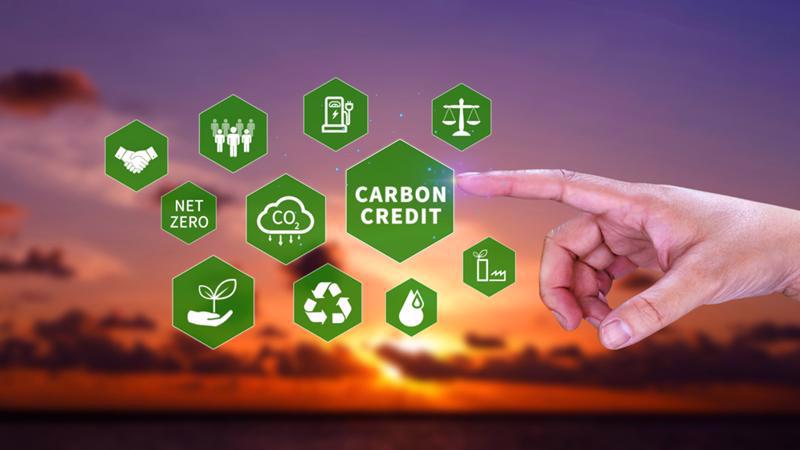Taking part in a carbon market presents significant challenges for many businesses, including complex administrative procedures, limited financial resources for investment, and a shortage of specialized expertise. Adopting a well-coordinated and comprehensive policy framework for the successful introduction of a carbon market is, however, not enough, as it is also essential that the entire process is transparent at every stage.
Building a robust carbon market is a critical step in advancing a green, sustainable economy and also key to fulfilling Vietnam’s international commitments, particularly those made at COP26 in Glasgow in 2021. Following the approved roadmap, Vietnam is set to launch a pilot program in 2025, with full implementation expected by 2028.
Speaking at the “Carbon Market: Challenges and Opportunities” seminar on December 25 in Hanoi, Mr. Hoang Van Tam, Head of the Climate Change Group within the Energy Efficiency and Sustainable Development Department at the Ministry of Industry and Trade (MoIT), highlighted that while the carbon market is intangible at this stage, it holds immense value and offers significant investment and business potential. However, the transition to the market poses numerous challenges for local businesses, especially considering that regional counterparts have been active in such a market for nearly a decade.
Cumbersome admin procedures
Ms. Dang Hong Hanh, Co-founder and Executive Director of the Vietnam Energy & Environmental Consultancy JSC, believes many Vietnamese businesses still lack understanding and interest in the Emissions Trading System (ETS) and the carbon market overall. One survey found that 53.16 per cent of businesses have heard of the ETS and the carbon market but do not understand the basic principles of how they work. Some 26.12 per cent of businesses possess some basic knowledge but do not fully grasp the differences between the ETS and the carbon market, and only 1.27 per cent have a clear understanding of how the ETS and the carbon market operate, their differences, and how they interact within the carbon exchange.
Meanwhile, the Truong Thanh Viet Nam Group is currently developing a 1,500 MW LNG power plant project in northern Thai Binh province, alongside researching and developing a direct power purchase agreement (DPPA) electricity sales mechanism and implementing near-shore and offshore wind energy projects. According to Mr. Vu Manh Thang from the Group’s Energy Division, participating in a carbon market is not only a legal obligation but also presents significant opportunities for energy businesses. By optimizing production processes, investing in clean technologies, and renewable energy, businesses can reduce emissions-related costs, improve their brand reputation, and enhance competitiveness in international markets. However, energy companies are currently facing several challenges. Mr. Thang emphasized that administrative procedures remain a key hurdle. Specifically, the processes of registering emission quotas, reporting emissions, and participating in the carbon market are still burdened by numerous complicated procedures and paperwork.
Moreover, the lack of coordination between the relevant ministries and agencies forces businesses to engage with multiple entities, leading to delays and difficulties in completing the necessary steps. The high cost of investing in emission reduction technologies also remains a significant barrier. Many businesses, particularly small and medium-sized enterprises (SMEs), lack the financial resources to invest in such technologies. While there are some financial support programs from the government and international organizations, accessing these funds is difficult due to complex procedures and stringent requirements.
Additionally, the shortage of specialized human resources, such as experts in carbon markets and emissions management, is another major challenge. This lack of expertise hinders businesses’ ability to formulate effective strategies and implement emissions reduction measures. Furthermore, limited information on pricing and trading processes, difficulties in finding international partners and customers, market and business risks, and fluctuating carbon prices all create obstacles for businesses wishing to engage in the carbon emissions trading market.
A representative from the Vietnam National Coal and Mineral Industries Group (Vinacomin) said it has been focusing on creating a roadmap for emissions reductions within its units. However, a significant challenge is the absence of specific carbon cap regulations, making it difficult to implement effectively.
Call for transparent regulations
To advance the carbon market, Mr. Thang believes that practical solutions are needed to help businesses adapt and take advantage of opportunities in the carbon emission market. First and foremost, the government must issue clear and transparent regulations while streamlining administrative procedures. Legal frameworks related to the carbon emission market must be developed in a transparent, consistent, and easy-to-understand manner, ensuring no overlaps or contradictions between various legal documents.
Additionally, financial support mechanisms and environmental funds need to be established, alongside incentives to attract international investments. Tax exemptions and financial incentives should be introduced for businesses that actively engage in reducing greenhouse gas emissions and adopting renewable energy sources.
From the business side, companies should work closely with relevant authorities to provide feedback and advocate for the issuance of specific guidelines related to the carbon market. This collaboration will help businesses fully understand their rights, responsibilities, and obligations. Furthermore, businesses should take the initiative to seek partnerships with international financial institutions, climate funds, and foreign investors interested in emission reduction efforts. They should also make use of financial and technical support programs offered by organizations like the World Bank, the Asian Development Bank, and the Green Climate Fund to gain access to capital and advanced technologies.
He also suggested that businesses assess and upgrade their equipment and production lines to enhance energy efficiency, reduce material waste, and minimize emissions. They should adopt new technologies such as solar power, wind energy, biomass, and energy storage solutions to reduce their dependence on fossil fuels.
Implementing international standards like ISO 50001 for energy management would help optimize energy use within companies. Businesses should also set up continuous greenhouse gas monitoring systems to enable timely adjustments and improvements in their environmental performance.
Mr. Thang also emphasized the importance of businesses regularly assessing risks related to carbon price fluctuations, policy changes, and market dynamics. This evaluation will allow them to create preventive strategies, develop flexible long-term business plans, and prepare for different scenarios in the carbon emission market. Ensuring that their products and services meet international standards for quality and sustainability will give businesses a competitive edge. Additionally, optimizing production and operational costs will improve overall business performance.
From a research perspective, Dr. Nguyen Sy Linh, Head of the Climate Change and Global Issues Department in the Institute of Strategy and Policy for Natural Resources and Environment at the Ministry of Natural Resources and Environment (MoNRE), pointed out that based on international experience, Vietnam needs to approach the issue of emissions inventory and quota allocation carefully.
It must also prepare, particularly by enhancing communications efforts to raise awareness, so that businesses clearly understand the difference between a compliance market and a voluntary market. This will enable businesses, consulting firms, and brokers to maximize their potential. In the early stages of the market’s implementation, responsible authorities should set a reasonable carbon credit exchange price to encourage businesses to participate.
According to Professor Nguyen The Chinh, Vice President of the Vietnam Association for Environmental Economics (VIASEE), the successful implementation of a carbon market is a complex task that involves not only policy frameworks but also effective execution. “Even with the right policies in place, if they are not executed properly, the objectives will not be met,” he said. “In practice, it is challenging to operate this system with just MoNRE overseeing it. Put simply, when one person designs and another operates, effective results are hard to achieve. This issue calls for a review of the regulations in the decree, and amendments should be made as soon as possible, even within the law.”
It’s also essential to thoroughly assess who will be responsible for each task and how it will be carried out, along with the necessary inspections and oversight to ensure compliance with legal documents and processes. These three aspects must function smoothly to ensure the success of the carbon market. Moreover, achieving societal consensus and ensuring market transparency are crucial, as without these the market may fail.









 Google translate
Google translate